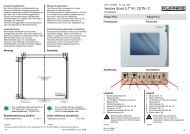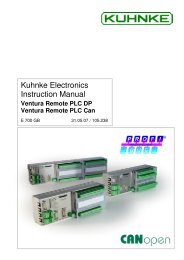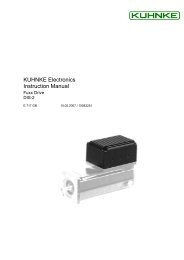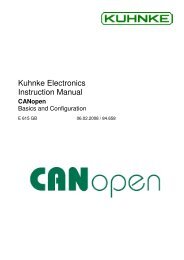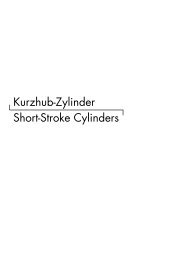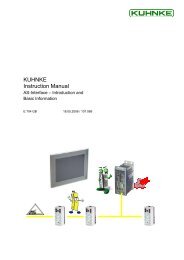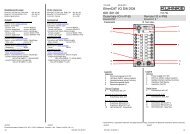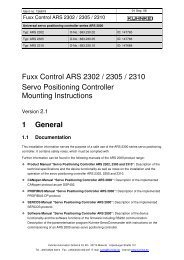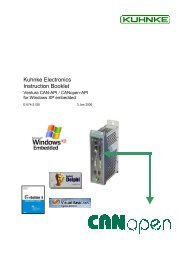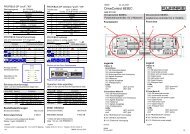Fuxx Control - ARS 2320 / ARS 2340 Instruction Manual - Kuhnke
Fuxx Control - ARS 2320 / ARS 2340 Instruction Manual - Kuhnke
Fuxx Control - ARS 2320 / ARS 2340 Instruction Manual - Kuhnke
Create successful ePaper yourself
Turn your PDF publications into a flip-book with our unique Google optimized e-Paper software.
<strong>Fuxx</strong> <strong>Control</strong> <strong>ARS</strong> <strong>2320</strong> / <strong>ARS</strong> <strong>2340</strong> KUHNKE Automation<br />
� Additional flags:<br />
� Relative / relative to last target / absolute<br />
� Wait for end / interrupt / ignore start<br />
� Synchronized<br />
� Rotary axis: Fixed direction of motion <br />
� Option: Automatic braking if there is no follow-up positioning run<br />
� Option: The driving speed can be changed continuously via an analog input in the course of<br />
the motion task .<br />
� Several options for setting up path programs<br />
The positioning sets can be addressed through all bus systems or using the ServoCommander<br />
parameterization software. The positioning process can be controlled via the digital inputs.<br />
5.3.2 Relative positioning<br />
In the case of relative positioning, the target position is added to the current position. As this does not<br />
require a fixed zero point, referencing is not compulsory. It does, however, make sense in many cases<br />
in order to bring the drive to a defined position.<br />
When several relative positioning sequences are added, e.g. for a trimming unit or a conveyor belt,<br />
endless positioning in one direction is possible (incremental dimension).<br />
5.3.3 Absolute positioning<br />
The position target is approached regardless of the current position. We recommend referencing the<br />
drive for absolute positioning. In the case of absolute positioning, the target position is a fixed<br />
(absolute) position with regard to the zero point or reference point.<br />
5.3.4 Driving profile generator<br />
Driving profiles can be divided into time-optimal and jerk-limited positioning profiles. For time-optimal<br />
positioning, the systems starts and stops with maximum predefined acceleration. The drive reaches<br />
the target in the shortest possible time. The velocity profile is trapezoidal while the acceleration profile<br />
is block-shaped. During jerk-limited positioning, the acceleration profile is trapezoidal and the velocity<br />
profile is therefore of third order. Since the acceleration changes steadily, the drive moves particularly<br />
gently with regard to the mechanical system.<br />
50 E 732 GB<br />
14.12.2006



